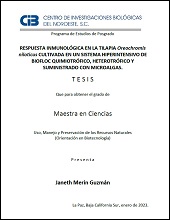Mostrar el registro sencillo del ítem
RESPUESTA INMUNOLÓGICA EN LA TILAPIA Oreochromis niloticus CULTIVADA EN UN SISTEMA HIPERINTENSIVO DE BIOFLOC QUIMIOTRÓFICO, HETEROTRÓFICO Y SUMINISTRADO CON MICROALGAS.
| dc.contributor.advisor | Estrada Muñoz, Norma Angélica | |
| dc.contributor.advisor | Magallón Servín, Paola | |
| dc.contributor.author | Merín Guzmán, Janeth | |
| dc.date.issued | 2023 | |
| dc.identifier.uri | http://dspace.cibnor.mx:8080/handle/123456789/3160 | |
| dc.description.abstract | La Tilapia del Nilo, Oreochromis niloticus, ocupa el segundo lugar a nivel mundial de producción dulceacuícola. El sistema de biofloc (TBF) es una tecnología amigable con el ambiente, que se caracteriza por el reciclaje de alimento no consumido y los desechos producidos por los organismos en forma de flóculos, en este sistema, el recambio de agua es mínimo y existe una gran densidad de animales por unidad de área. El TBF es considerado como una estrategia para el control de enfermedades, con diversos compuestos bioactivos presentes en los flóculos a los cuales se les atribuye un papel importante en el desarrollo y estimulación del sistema inmunológico de los peces. Los peces teleósteos poseen un sistema inmune capaces de llevar a cabo respuestas humorales y celulares tanto innatas como específicas, donde el plasma de la sangre forma parte de los principales indicadores de salud del organismo. El objetivo fue determinar la respuesta inmunológica en plasma sanguíneo de O. niloticus cultivada en sistemas hiperintensivos de TBF. Se llevaron a cabo 5 tratamientos: 1) TBF heterotrófico (control); 2) TBF quimiotrófico; 3) TBF suministrado con Chlorella sp; 4) TBF suministrado con Chlorella sorokiniana 2714; y 5) TBF suministrado con Chlorella sorokiniana 2805. A las 40 semanas de comenzado el experimento se extrajo la sangre vía punción de la vena caudal y se centrifugó para obtener el plasma. Se analizaron las actividades enzimáticas de superóxido dismutasa (SOD), antiproteasa, proteasa, fosfatasa alcalina y peroxidasa mediante espectrofotometría, se evaluó también la capacidad bactericida del plasma con una cinética de crecimiento de bacterias patógenas del género Exiguobacterium. Los resultados muestran que la enzima antiproteasa presentó una diferencia significativa en el BFT quimiotrófico comparado con el control. Asimismo, los sistemas TBF suministrados con Chlorella sp y C. sorokiniana presentan una diferencia significativa de la enzima SOD con respecto al control y al TBF quimiotrófico. Los resultados muestran que hay un beneficio en el rendimiento productivo de los peces en el sistema, lo que nos indica que los microorganismos, incluyendo a las microalgas en los sistemas TBF, son una fuente importante de compuestos bioactivos que estimulan el sistema inmune en O. niloticus. | es |
| dc.format | es | |
| dc.language.iso | spa | es |
| dc.publisher | Centro de Investigaciones Biológicas del Noroeste, S.C. | es |
| dc.rights | Acceso abierto | es |
| dc.subject | tecnología biofloc (TBF), respuesta inmune, plasma, tilapia, enzimas | es |
| dc.subject | Biofloc technology (BFT), immune response, plasma, tilapia, enzymes | es |
| dc.title | RESPUESTA INMUNOLÓGICA EN LA TILAPIA Oreochromis niloticus CULTIVADA EN UN SISTEMA HIPERINTENSIVO DE BIOFLOC QUIMIOTRÓFICO, HETEROTRÓFICO Y SUMINISTRADO CON MICROALGAS. | es |
| dc.type | masterThesis | es |
| dc.dirtesis.grado | Maestría en Ciencias en el Uso, Manejo y Preservación de los Recursos Naturales | es |
| dc.dirtesis.disciplina | Biotecnología | es |
| dc.dirtesis.universidad | Centro de Investigaciones Biológicas del Noroeste, S.C. | es |
| dc.dirtesis.facultad | Posgrado en Recursos Naturales | es |
| dc.description.abstracten | Nile tilapia, Oreochromis niloticus, is the second freshwater fish with the most significant production worldwide. Biofloc technology (BFT) is characterized by recycling feed and waste produced by the organisms into the flocs, a minimal exchange of water, and reducing water and space compared with other rearing technologies. In addition, BFT is considered a strategy for disease control, with various bioactive compounds present in the flocs (flocculated organic matter in addition to microorganisms), which have an important role in the development and stimulation of fish’s immune system. Teleost fish have an immune system capable of carrying out both innate and specific humoral and cellular responses. Blood plasma is one of the leading indicators of this system. This project aimed to evaluate the immunological response in the blood plasma of O. niloticus cultured in BFT hyperintensive systems. Five treatments were established: 1) heterotrophic BFT (control); 2) chemotrophic BFT; 3) BFT with Chlorella sp; 4) BFT with Chlorella sorokiniana 2714, and 5) BFT with Chlorella sorokiniana 2805. After 40 weeks of the experiment, blood was extracted from the caudal vein and centrifuged to obtain plasma. We measured the enzymatic activities of superoxide dismutase (SOD), antiprotease, protease, alkaline phosphatase, and peroxidase. All of them were analyzed by spectrophotometry and the bactericidal capacity of the genus Exiguobacterium. The results showed that the antiprotease enzyme had a significant difference in the chemotrophic BFT compared to the control. Likewise, the BFT systems with Chlorella sp. and C. sorokiniana had a significant difference in the SOD enzyme concerning the control and the chemotrophic BFT. The results show that there is a benefit in the productive performance of the fish in the system, which indicates that microorganisms, including microalgae in TBF systems, are an important source of bioactive compounds that stimulate the immune system in O. niloticus. | es |

